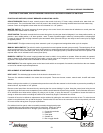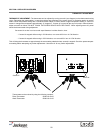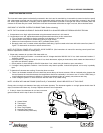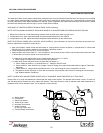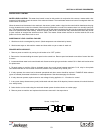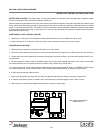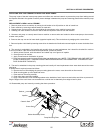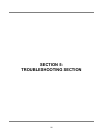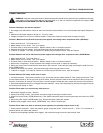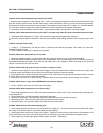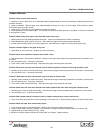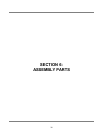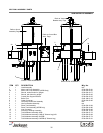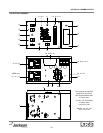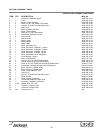
27
SECTION 5: TROUBLESHOOTING
COMMON PROBLEMS
WARNING: Inspection, testing and repair of electrical equipment should only be performed by a qualified service tech-
nician. Many of the tests require that the unit have power to it and live electrical components be exposed. USE
EXTREME CAUTION WHEN TESTING THE MACHINE.
Problem: Nothing on the machine operates.
1. No voltage to the dishmachine. Check to see if the customer’s fuse has blown or the circuit breaker has tripped. Replace or
reset.
2. Machine circuit breaker tripped or turned off. Turn on or reset.
3. Voltage to machine low or circuit to machine broken. Contact your electrician and/or power company for repair.
Problem: Machine will not fill with electrical power applied, even though other components work. (AB Model)
1. Water hand valve off. Turn hand valve on.
2. Master switch not on or faulty. Turn on or replace.
3. Fill switch faulty or loose wire connection. Replace switch or wire or connection terminal.
4. Solenoid valve does not operate. See instructions page concerning the solenoid valve.
5. Y-Strainer is clogged. Turn water to machine off, remove plug and strainer screen, clean and replace.
Problem: Machine will not fill with electrical power applied even though other components work. (APRB Model)
1. Water hand valve off. Turn hand valve on.
2. Master switch not on or faulty. Turn on or replace.
3. Fill switch faulty or loose wire connection. Replace switch or wire or connection terminal.
4. Rinse motor not operating. Check connection and voltage to motor repair or replace as necessary.
5. Water level control does not maintain the water level in the rinse tank. See instruction page concerning the water level con-
trol for APRB Models.
6. Solenoid valve does not operate. See instructions page concerning the solenoid valve.
7. Y-Strainer is clogged. Turn water to machine off, remove plug and strainer screen, clean and replace.
Problem: Machine fills slowly and/or rinse is weak.
1. Low water pressure. Check water pressure by first, turning the heat and master switch off. Next, empty the wash tub. Then
turn the master switch on, and as you push up the fill switch, time the seconds it takes to fill the machine to the top of the over-
flow tube. It should be 35 seconds. Any more than 5 seconds longer indicates the water supply and pressure and insufficient.
2. Rinse head assemblies limed up or clogged with other deposits. Clean rinse head tubes by removing end plugs and push
the cleaning brush though to clean.
Problem: Rinse water runs continuously with power on.
1. Rinse switch sluggish or faulty. Replace.
2. Solenoid valve dirty or faulty. See special instructions page concerning the solenoid valve.
3. Water level control faulty. (APRB Models only) See special instructions page concerning the water level control for APRB
Models.
4. Rinse tank probe coated. (APRB Models only) Remove and clean probe then replace.
5. Breather tube plugged or bent closed. (APRB Model only) Clean or replace tube.
Problem: Rinse water runs with no electrical power applied to the solenoid (master switch is off).
1. Water pressure excessive. Check the pressure gauge during flow period, it should read 20 A 5 PSI. If it is excessive, a
pressure reducer can reduce the pressure.
2. Solenoid valve diaphragm breather hole clogged. See instructions page concerning the solenoid valve.



